TOYOTA CAMRY 2011 XV50 / 9.G Owners Manual
Manufacturer: TOYOTA, Model Year: 2011, Model line: CAMRY, Model: TOYOTA CAMRY 2011 XV50 / 9.GPages: 554, PDF Size: 9.69 MB
Page 421 of 554

420 4-3. Do-it-yourself maintenance
11 PWR25 A Power windows
12 DOOR NO.2 25 A Main body ECU
13 S/ROOF 30 A Moon roof
14 TAIL 15 AFront side marker/parking lights,
stop/tail lights, rear side marker
lights, license plate lights, back-up
lights, front turn signal lights, main
body ECU
15 PANEL 7.5 ANavigation system, seat heaters,
emergency flashers, air condition-
ing system, audio system, clock,
glove box light, instrument panel
lights, steering switches, vehicle
stability control system, traction
control system
16 ECU IG NO.1 10 A Main body ECU, windshield wipers
and washer, moon roof, tire pres-
sure warning system, electric cool-
ing fans, auto anti-glare inside rear
view mirror, navigation system
17 ECU IG NO.2 7.5 A Anti-lock brake system, vehicle sta-
bility control system, traction con-
trol system, brake assist system,
shift lock control system, auto-
matic transmission, cruise control
system
18 A/C NO.2 10 AAir conditioning system, rear win-
dow defogger
19 WASH 10 A Windshield wipers and washer
20 S-HTR 20 A Seat heaters
21 GAUGE NO.1 10 A Emergency flashers, charging sys-
tem, multiport fuel injection system/
sequential multiport fuel injection
system, back-up lights
FuseAmpereCircuit
Page 422 of 554
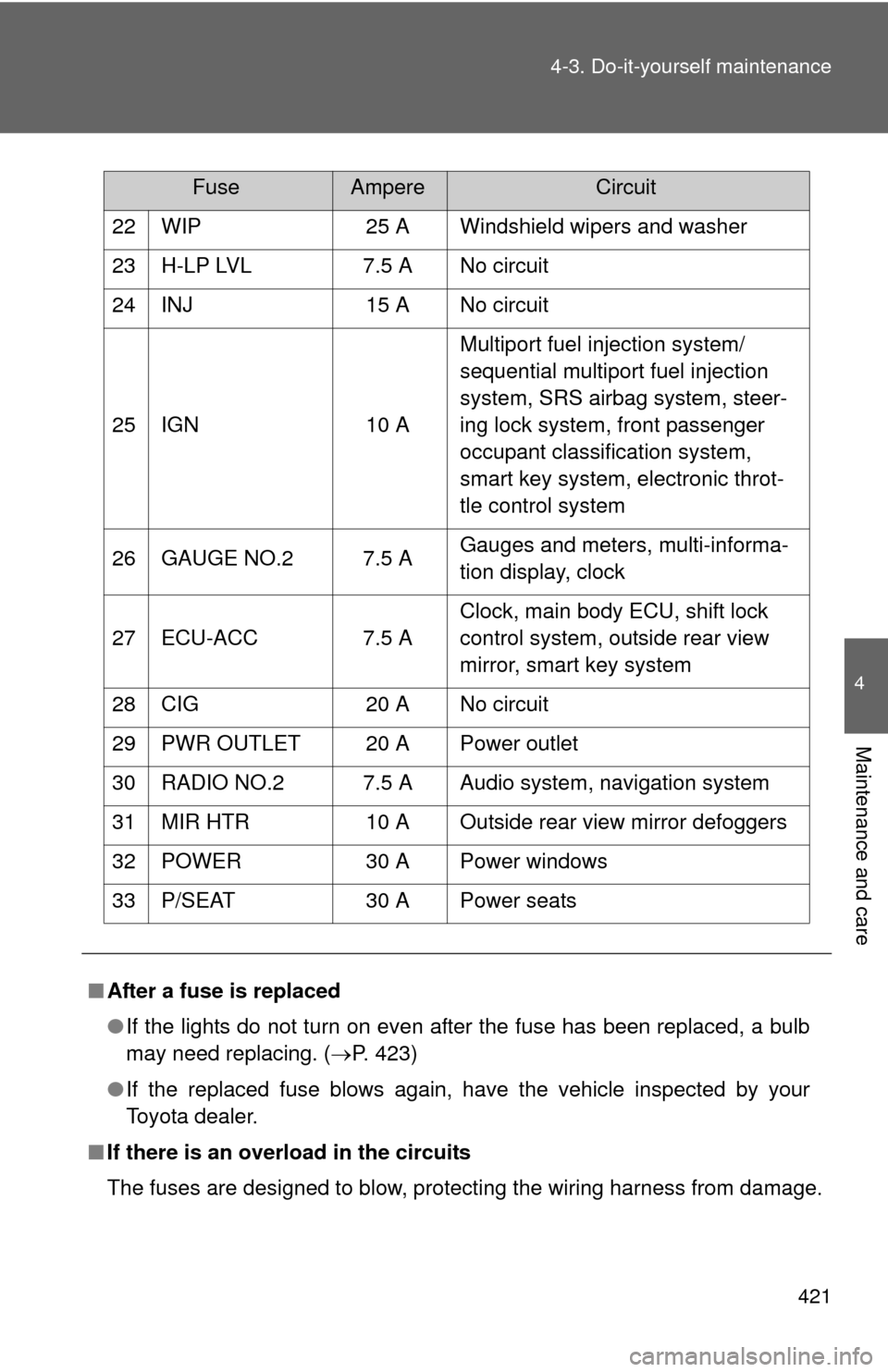
421
4-3. Do-it-yourself maintenance
4
Maintenance and care
22 WIP
25 A Windshield wipers and washer
23 H-LP LVL 7.5 A No circuit
24 INJ 15 A No circuit
25 IGN 10 AMultiport fuel injection system/
sequential multiport fuel injection
system, SRS airbag system, steer-
ing lock system, front passenger
occupant classification system,
smart key system, electronic throt-
tle control system
26 GAUGE NO.2 7.5 A Gauges and meters, multi-informa-
tion display, clock
27 ECU-ACC 7.5 A Clock, main body ECU, shift lock
control system, outside rear view
mirror, smart key system
28 CIG 20 A No circuit
29 PWR OUTLET 20 A Power outlet
30 RADIO NO.2 7.5 A Audio system, navigation system
31 MIR HTR 10 A Outside rear view mirror defoggers
32 POWER 30 A Power windows
33 P/SEAT 30 A Power seats
■ After a fuse is replaced
●If the lights do not turn on even after the fuse has been replaced, a bulb
may need replacing. ( P. 423)
● If the replaced fuse blows again, have the vehicle inspected by your
Toyota dealer.
■ If there is an overload in the circuits
The fuses are designed to blow, protecting the wiring harness from damage.
FuseAmpereCircuit
Page 423 of 554
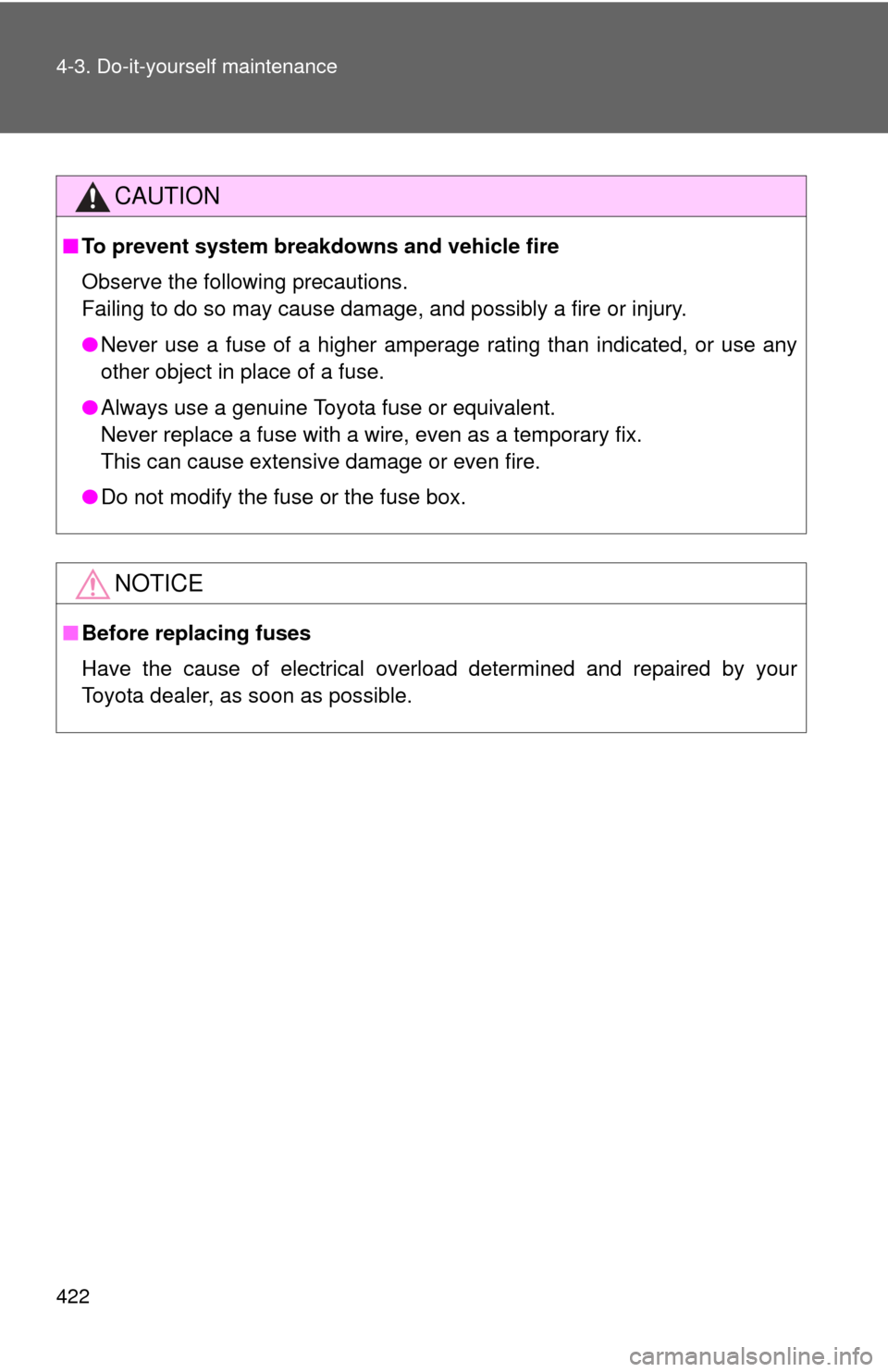
422 4-3. Do-it-yourself maintenance
CAUTION
■To prevent system breakdowns and vehicle fire
Observe the following precautions.
Failing to do so may cause damage, and possibly a fire or injury.
●Never use a fuse of a higher amperage rating than indicated, or use any
other object in place of a fuse.
● Always use a genuine Toyota fuse or equivalent.
Never replace a fuse with a wire, even as a temporary fix.
This can cause extensive damage or even fire.
● Do not modify the fuse or the fuse box.
NOTICE
■Before replacing fuses
Have the cause of electrical overload determined and repaired by your
Toyota dealer, as soon as possible.
Page 424 of 554
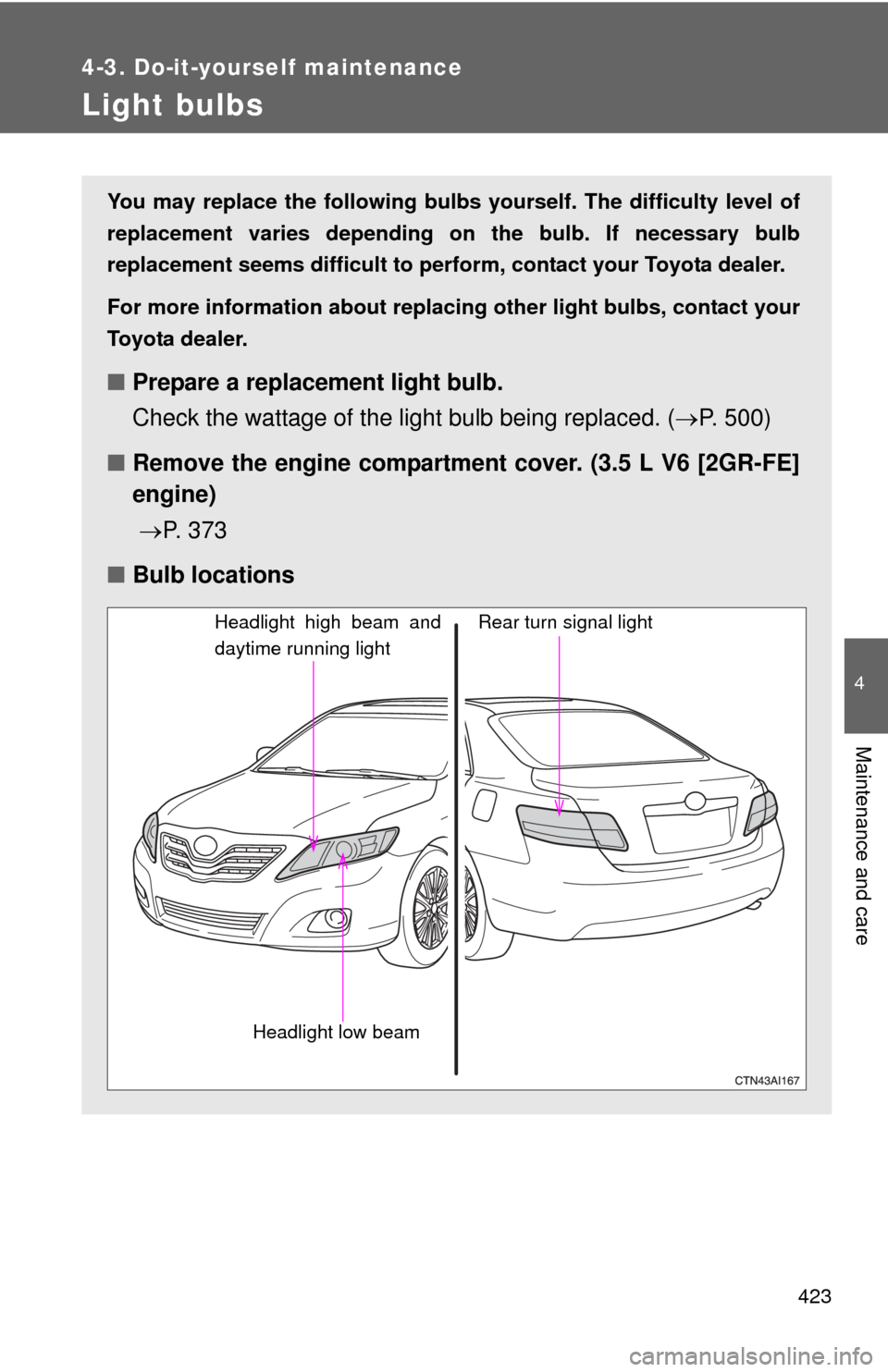
423
4-3. Do-it-yourself maintenance
4
Maintenance and care
Light bulbs
You may replace the following bulbs yourself. The difficulty level of
replacement varies depending on the bulb. If necessary bulb
replacement seems difficult to perfor m, contact your Toyota dealer.
For more information about replacing other light bulbs, contact your
Toyota dealer.
■ Prepare a replacement light bulb.
Check the wattage of the light bulb being replaced. ( P. 500)
■ Remove the engine compartment cover. (3.5 L V6 [2GR-FE]
engine)
P. 3 7 3
■ Bulb locations
Headlight high beam and
daytime running light
Headlight low beam
Rear turn signal light
Page 425 of 554
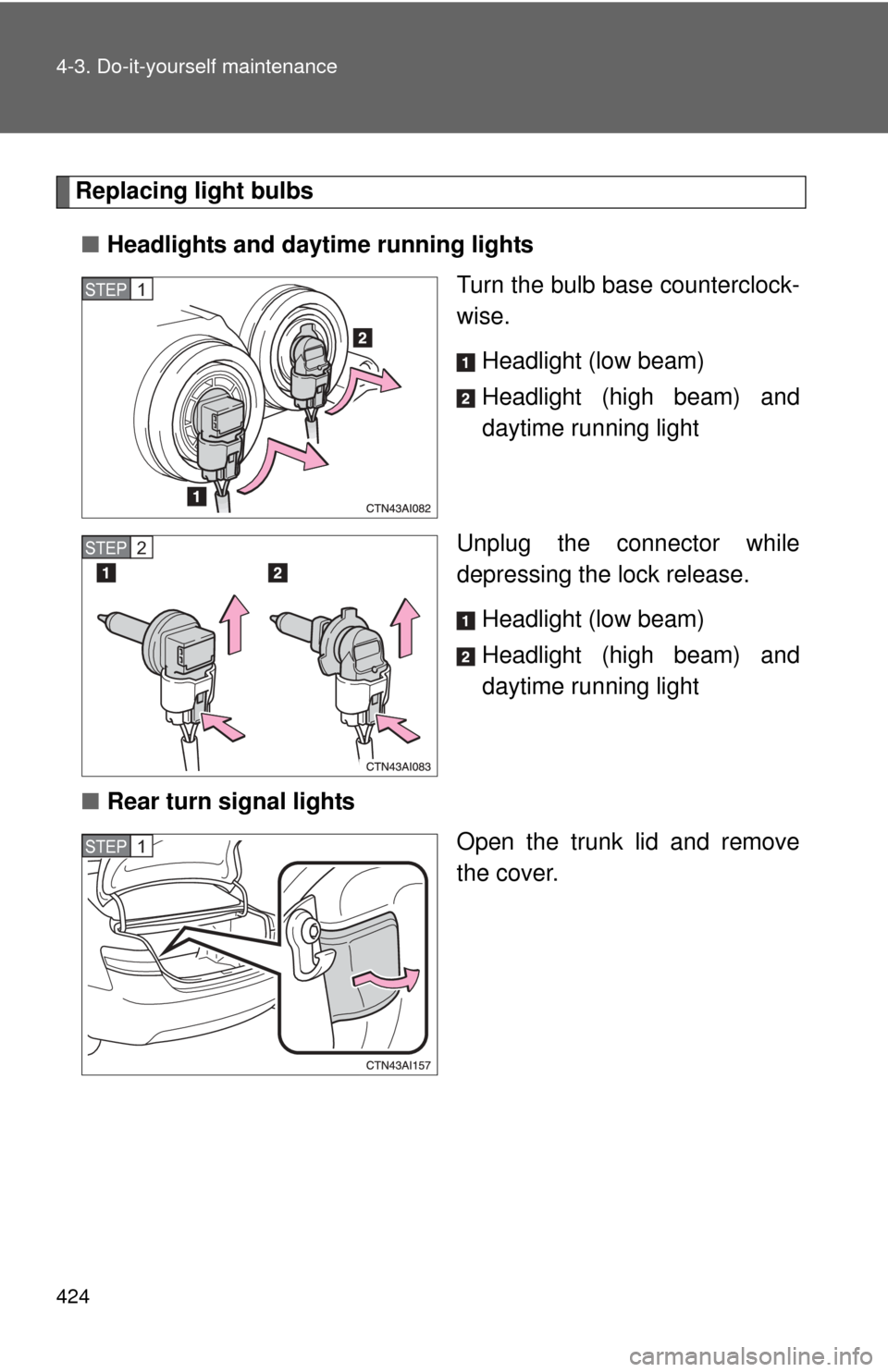
424 4-3. Do-it-yourself maintenance
Replacing light bulbs■ Headlights and daytime running lights
Turn the bulb base counterclock-
wise.
Headlight (low beam)
Headlight (high beam) and
daytime running light
Unplug the connector while
depressing the lock release. Headlight (low beam)
Headlight (high beam) and
daytime running light
■ Rear turn signal lights
Open the trunk lid and remove
the cover.
STEP1
STEP2
STEP1
Page 426 of 554
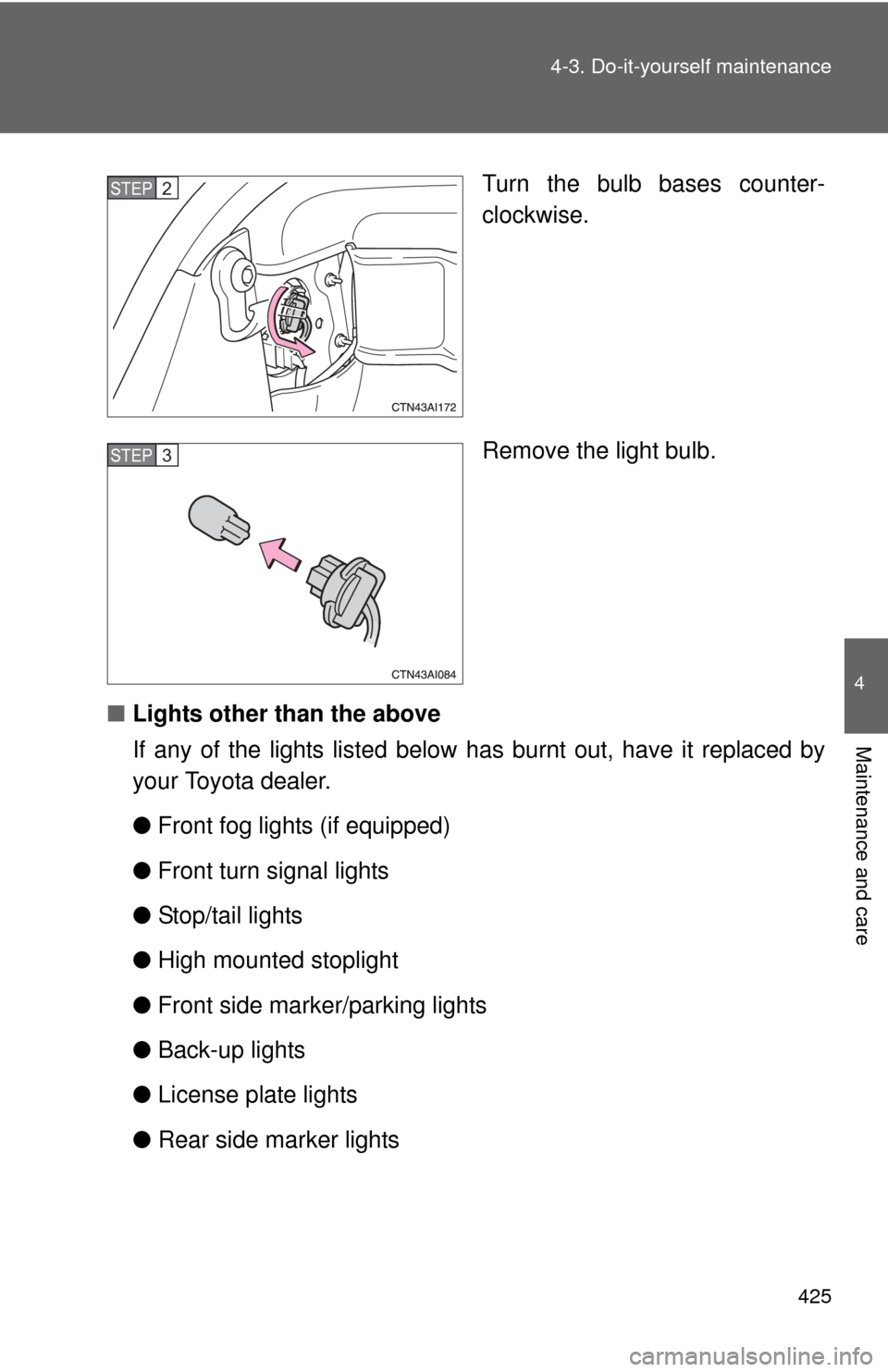
425
4-3. Do-it-yourself maintenance
4
Maintenance and care
Turn the bulb bases counter-
clockwise.
Remove the light bulb.
■ Lights other than the above
If any of the lights listed below has burnt out, have it replaced by
your Toyota dealer.
● Front fog lights (if equipped)
● Front turn signal lights
● Stop/tail lights
● High mounted stoplight
● Front side marker/parking lights
● Back-up lights
● License plate lights
● Rear side marker lightsSTEP2
STEP3
Page 427 of 554
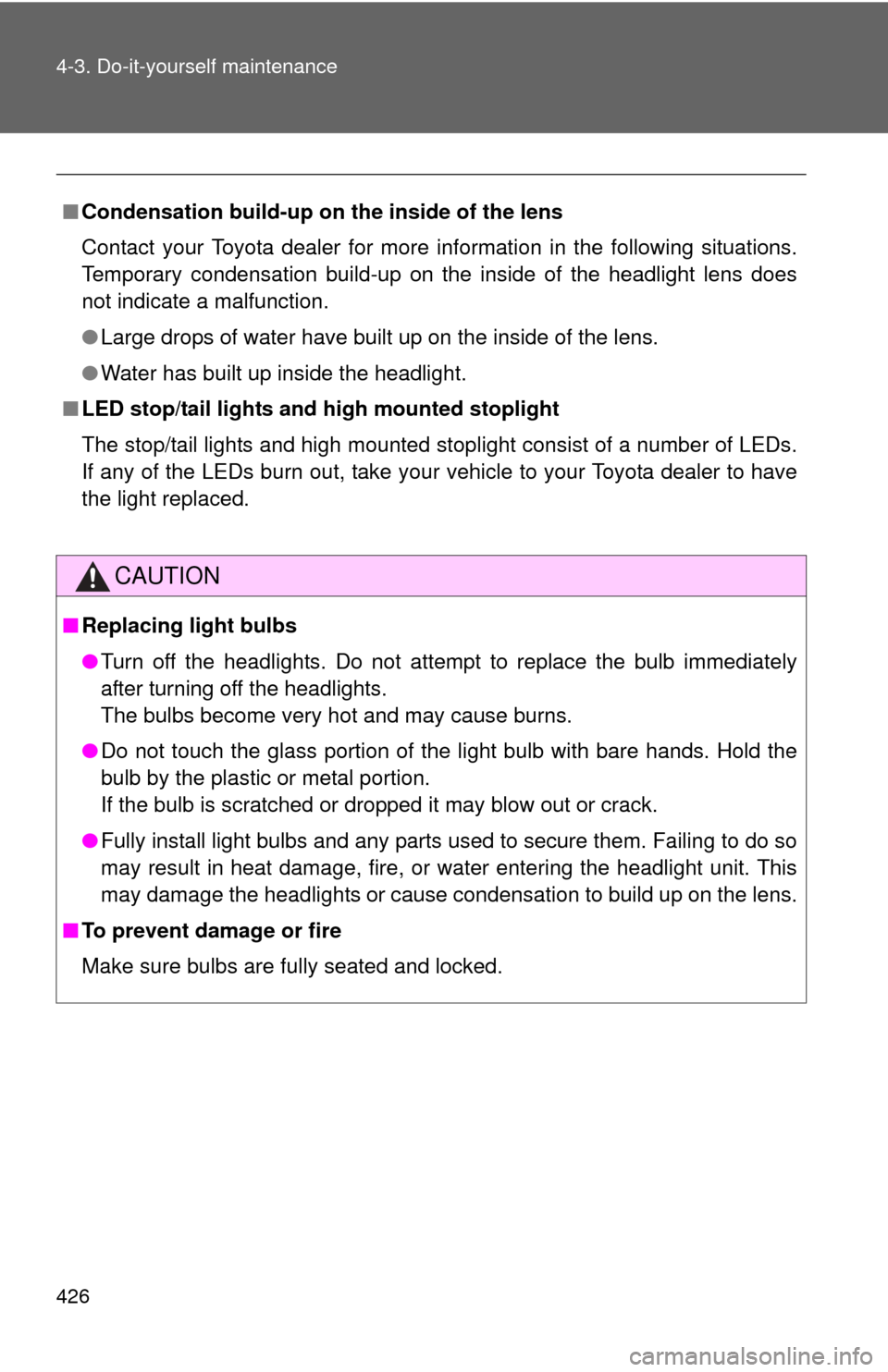
426 4-3. Do-it-yourself maintenance
■Condensation build-up on th e inside of the lens
Contact your Toyota dealer for more information in the following situations.
Temporary condensation build-up on the inside of the headlight lens does
not indicate a malfunction.
● Large drops of water have built up on the inside of the lens.
● Water has built up inside the headlight.
■ LED stop/tail lights and high mounted stoplight
The stop/tail lights and high mounted stoplight consist of a number of LEDs.
If any of the LEDs burn out, take your vehicle to your Toyota dealer to have
the light replaced.
CAUTION
■Replacing light bulbs
●Turn off the headlights. Do not attempt to replace the bulb immediately
after turning off the headlights.
The bulbs become very hot and may cause burns.
● Do not touch the glass portion of the light bulb with bare hands. Hold the
bulb by the plastic or metal portion.
If the bulb is scratched or dropped it may blow out or crack.
● Fully install light bulbs and any parts used to secure them. Failing to do so
may result in heat damage, fire, or water entering the headlight unit. This
may damage the headlights or cause condensation to build up on the lens.
■ To prevent damage or fire
Make sure bulbs are fully seated and locked.
Page 428 of 554
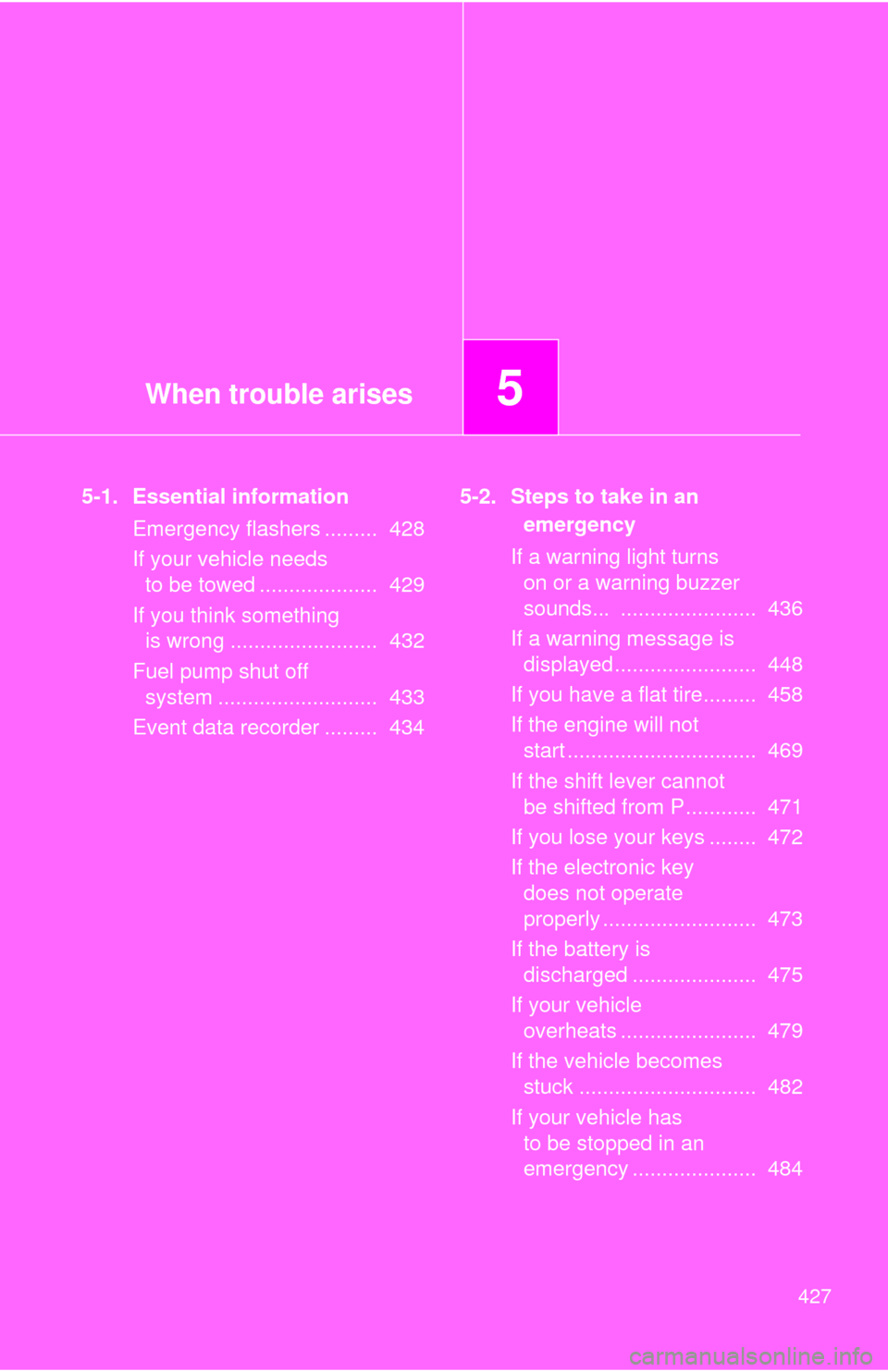
When trouble arises5
427
5-1. Essential informationEmergency flashers ......... 428
If your vehicle needs to be towed .................... 429
If you think something is wrong ......................... 432
Fuel pump shut off system ........................... 433
Event data recorder ......... 434 5-2. Steps to take in an
emergency
If a warning light turns on or a warning buzzer
sounds... ....................... 436
If a warning message is displayed........................ 448
If you have a flat tire......... 458
If the engine will not start ................................ 469
If the shift lever cannot be shifted from P............ 471
If you lose your keys ........ 472
If the electronic key does not operate
properly .......................... 473
If the battery is discharged ..................... 475
If your vehicle overheats ....................... 479
If the vehicle becomes stuck .............................. 482
If your vehicle has to be stopped in an
emergency ..................... 484
Page 429 of 554
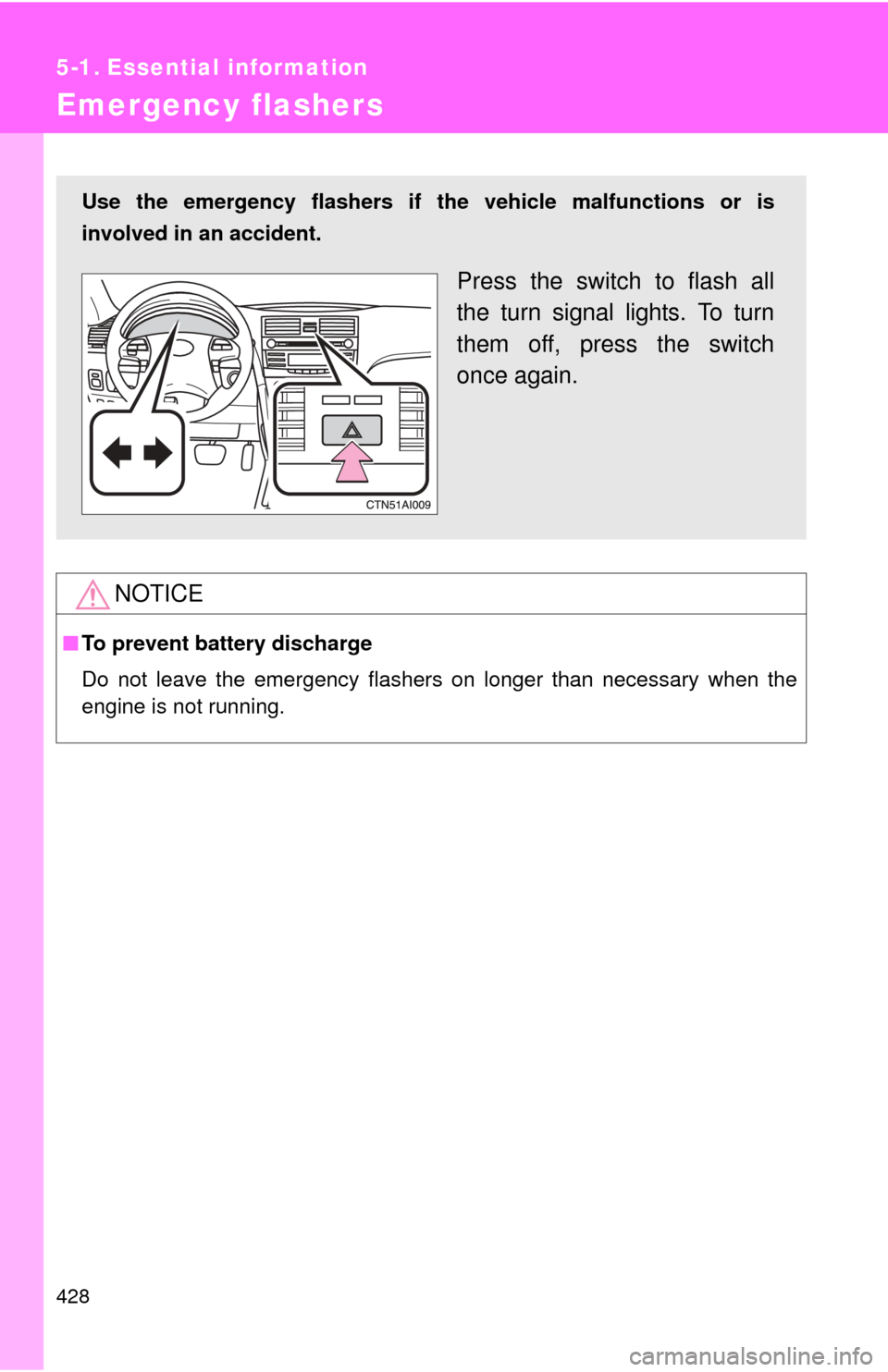
428
5-1. Essential information
Emergency flashers
NOTICE
■To prevent battery discharge
Do not leave the emergency flashers on longer than necessary when the
engine is not running.
Use the emergency flashers if th e vehicle malfunctions or is
involved in an accident.
Press the switch to flash all
the turn signal lights. To turn
them off, press the switch
once again.
Page 430 of 554
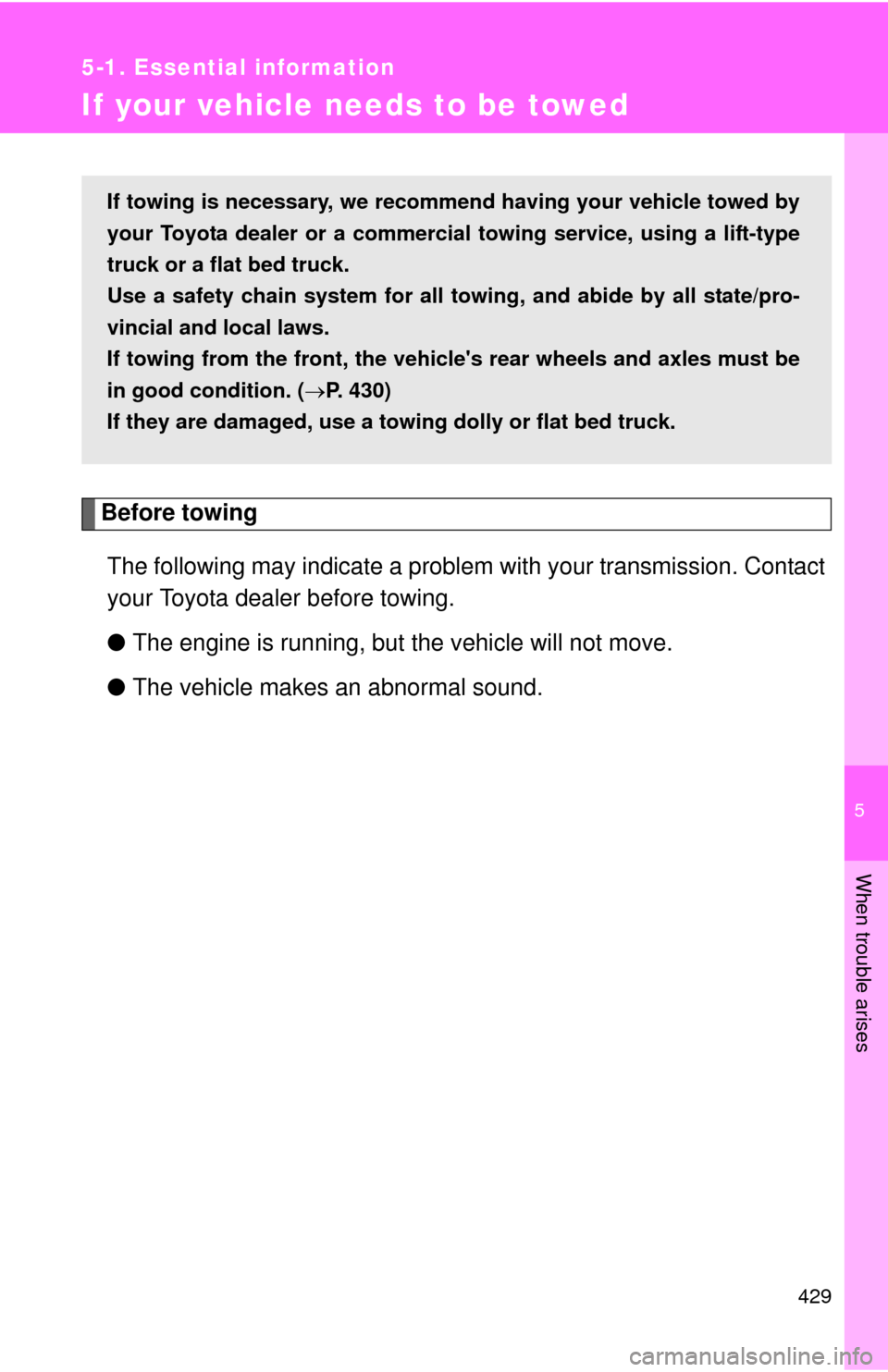
5
When trouble arises
429
5-1. Essential information
If your vehicle needs to be towed
Before towingThe following may indicate a problem with your transmission. Contact
your Toyota dealer before towing.
● The engine is running, but the vehicle will not move.
● The vehicle makes an abnormal sound.
If towing is necessary, we recommend having your vehicle towed by
your Toyota dealer or a commerci al towing service, using a lift-type
truck or a flat bed truck.
Use a safety chain system for all to wing, and abide by all state/pro-
vincial and local laws.
If towing from the front, the vehic le's rear wheels and axles must be
in good condition. (P. 430)
If they are damaged, use a towing dolly or flat bed truck.